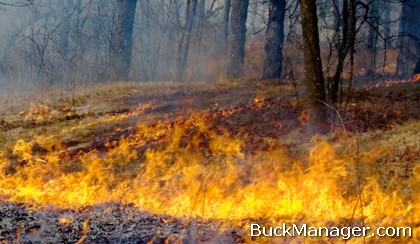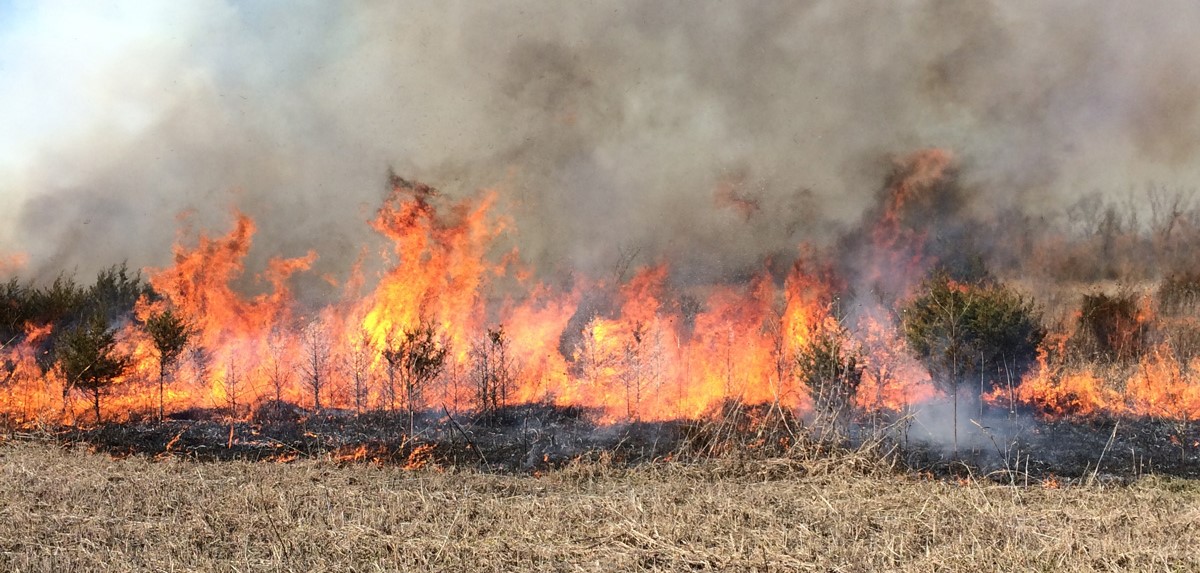The wildfires plaguing various parts of Texas have got me thinking a lot about prescribed burning over the past few days. Prescribed burning, prescribed fire, controlled burning, or however one refers to it, is a tool used for many purposes. It is commonly used for white-tailed deer habitat improvement, but it can also be used to prevent, contain and extinguish wildfires.
In recent years, prescribed fire for range and wildlife habitat improvement has increased substantially. Granted it’s not for everyone, but many land managers understand the utility of this management cost efficient management practice (which is also a naturally occurring process).
Prescribed burning is a tool used by land managers for increasing forage quality for livestock, reducing and controlling invasive brush species and for actively managing wildlife habitat. In fact, prescribed fire can accomplish many objectives simultaneously. For example, one fire be used to reduce brush cover, eliminate fine fuel loads, increase forage quality for wild and domestic animals, and improve wildlife habitat for deer, turkey and quail. Fire sets back many woody species and eliminates fire intolerant ones such as ashe juniper (cedar).

Why Use Prescribed Fire?
Prescribed fire is used to reduce fuel loads (existing dead and dormant vegetation) and reduce the threat and severity from wildfires should one occur. Prescribed fires also reduces woody plant encroachment and are beneficial for many native plant species in a way mechanical and chemical management treatments cannot duplicate.
Wildlife, both game and nongame species, also benefit from prescribed fires which results in new plant growth and restoration of habitats which they use both for both food and cover. Benefits from prescribed fire include:
- Reduce hazardous fuels, protect communities from wildfires
- Reduce the spread of pests and disease
- Provide habitat and forage for game and nongame species
- Recycle nutrients back into the soil
- Promote native species
- Promote a diverse natural landscape
Prescribed Burns Often Misunderstood
Most landowners realize that not all fire is bad. Wildfires are bad when the loss of life and property are involved, but prescribed, controlled fires are not. Often times, the vegetation found on a particular property requires a managed fire, not a wildfire, to come along at the right time and under the right conditions in a controlled manner. This is prescribed burning.
Once the objectives of the fire are determined and the conditions under which the fire should be used are established, it is only then than a prescription for carrying out the fire have been developed.
The prescription should include landowner objectives, personnel requirements, firebreaks and environmental factors such as air temperature, relative humidity and wind direction and speed. The bulk of the work takes place long before the first flame hits the ground. However, proper land management after the burn is essential for both wildlife and livestock. Cattle frequently concentrate on a burn because forage is more palatable and nutritious. However, this does not mean these grass-eating machines should be released onto burn sites immediately. As with any major event, some rest is warranted afterword.

Fire is a Tool for Active Managers
As with many tools, the quality of the work depends on how good you are with the tool. Prescribed fire for brush management/control and deer habitat improvement is no different. Without a doubt, experience is the best teacher of fire behavior. Inexperienced managers can learn a lot by observing prescribed fires lit by other folks. Considerable knowledge can be learned about fire behavior relatively quickly, but it takes years of experience to get good, but even then you will not (should not) feel totally confident. Even trained professionals do not lose their fear of what fire can do.
The benefits of controlled burning for wildlife are well documented. Burning is good for deer because of the nutrient-rich browse and forbs that respond post-fire. Fire also knocks back many of the root-sprouting browse species that have outgrown the reach of deer. Fire promotes native grasses, which in turn creates better quail nesting habitat, improved water infiltration, and drought-tolerant forage. Additionally, fire is a relatively inexpensive management tool, especially for landowners interested in controlling cedar. Costs can range from $2 to $8 per acre depending on the size of the burn, prep work, and personnel needs.
To wrap up, prescribed fires have different uses depending on the objectives. The most common use of controlled burns is to reduce fuels such as pine needles, leaves and dead herbaceous vegetation such as grass and weeds. Controlled burning can also be used for brush control and quail, turkey and white-tailed deer habitat improvement. Although prescribed burning is a very effective tool, it can be incorrectly applied. Prescribed fire, just like any habitat management practice, should only be implemented once the need has been completely evaluated and deemed effective for achieving the desired objectives.
I agree with your article and controlled burns can have a significant impact on one’s property. There are a few other items that I would like to volunteer. We’ve been running controlled burns for more than 10 years and we’ve dealt with every possible mishap that exists… which has made us more efficient.
First, have someone experienced in CONTROLLED burns helping…having about 10 people or more is ideal…the more the better.
Second, burn a 15-20 yard perimeter around the area you intend to burn…performed previous to the burn to hopefully keep the fire from jumping.
Third, don’t plan on burning your entire property. You’ll give the deer nothing to eat (as this is usually done in the winter) since you’ve burned all available food sources.
Fourth, don’t burn the same sections consecutive years. Usually wait 3-5 years before burning that area again to allow certain forbs to sprout and avoid killing out your forbs completely.
Lastly…and most importantly…have A LOT of water. We mix in a little soap as a surfactant that helps kill the fire quickly. We run 2 4-wheelers with 50 gallon sprayers, a mule with a 50 gallon sprayer, a 4X4 truck with a 2,000 gallon hose and another 4X4 with a 3,000 gallon tank and hose that would rival a firetruck’s. That’s what it takes with 4-5 others lighting on the ground.
Everyone underestimates the power fire can have. It can get away from you in a second when the wind changes and blows embers across the fence…then you have real problems…we’re experienced and it happened to us…fortunately we had enough water to keep it from really getting anywhere. The moment you stop thinking that fire is a real danger is the moment it gets away from you and kills someone or jumps a barrier and burns 10,000 acres…and you’ll be sued for everything you own for your mistake…it happens and I’ve seen it.
If you’ve never burned before, find someone who’s experienced and doing a controlled burn and volunteer. I guarantee they won’t turn down extra help. You’ll gain experience and you’ll also be able to ask if they can help with yours.
Being fortunate to have been on several burns through out Central and South Texas, I too can agree with Hunter D and the author. While several objectives were used based on the land owner’s needs we found that a prescribed burn has many positive effects. In South Texas we used prescribed burns mainly to open canopies up and allow grasses to grow. This also allowed much needed forbs to grow for wildlife.
Central Texas has shown a very positive response to burns through cedar removal with native species of grass responding too. I will agree that the process must be prescribed correctly so the procedure can be carried out in the safest manner possible.
A very good man told me once… ” If your gut doesn’t turn when you light that first match, walk away.” Moral of the story is education and outfitting all parties involved with as much education as possible will save lives, property and curtail major problems. Consult with a burn boss or a state/federal agency that has working knowledge in prescribed burns first.
Burning is a great way to keep cedar under control. We use it on pastures in north central Texas about every 4 years and have been thrilled with the results. Our neighbors think we are a little crazy, but they will also tell you that our property looks amazing, while the cedar on their property is getting taller and thicker. Most of the work is prep work then looking for the right conditions to light a match.
Prescribed burning is a disgusting mismanagement of land. The author of this article says: “Prescribed burning can set back woody species.” He says this as if it were a good thing. Destroying trees and preventing them from reproducing is awful. It destroys forests and kills one of the most important living organisms on the planet.
Jesse,
Prescribed burning does not “destroy forests.” It does push back woody species, but not to the disadvantage of the other vegetation… as a burn will provide nutrients to the soil for the other trees and vegetation.
If you truly care about trees to the degree you state, then I assume no trees were bulldozed to place the house you live in, you don’t use paper to write on, and you wipe your rear end with recycled paper… because otherwise YOU are killing trees.
Fires from cigarettes and sparks from engines from roadsides kill more trees in a month than prescribed burning kills in decades.
Jesse,
Prescribed burning is an important tool in PREVENTING exactly the type of devestating fire you’re talking about. It’s only because of uneducated but well-meaning greenies like you that huge forest fires have become an annual phenomenon.
Prescribed fire really is a good tool. We looked into it a couple years ago and then got our first burn in this past winter. Deer habitat looks amazing and we expect it to stay highly desirable to deer for several more years.
It does take some planning, but the cost per acre is low for the acreage and duration of enhancement.